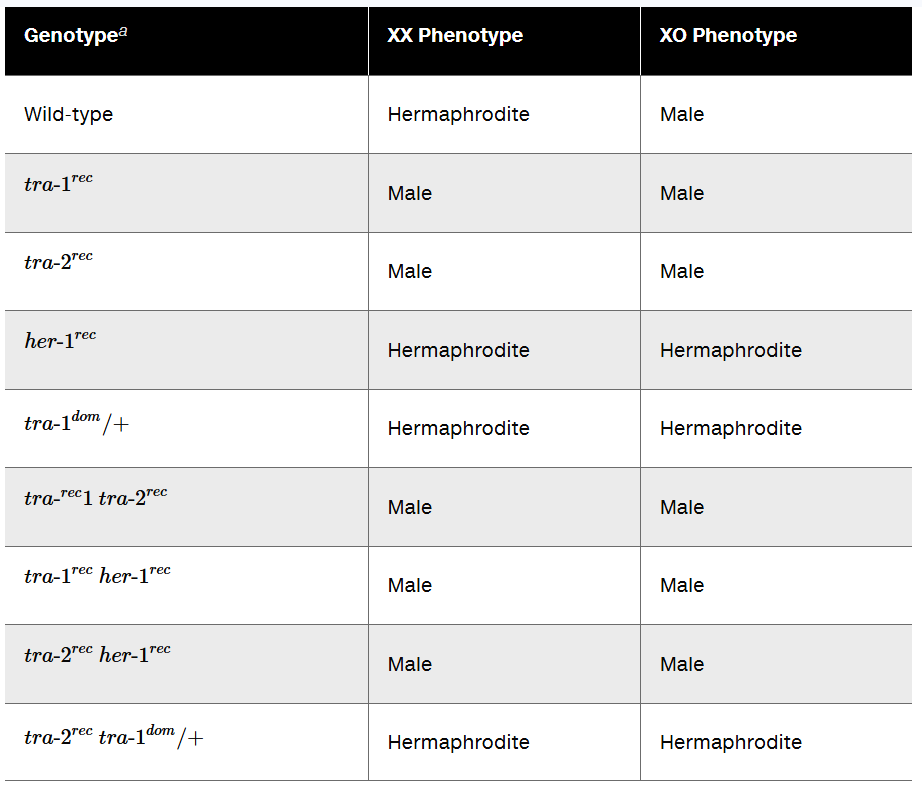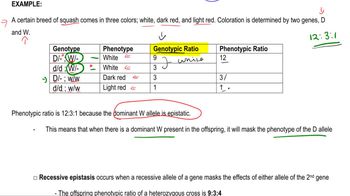In mice, the Sry gene is located on the Y chromosome very close to one of the pseudoautosomal regions that pairs with the X chromosome during male meiosis. Given this information, propose a model to explain the generation of unusual males who have two X chromosomes (with an Sry-containing piece of the Y chromosome attached to one X chromosome).
Table of contents
- 1. Introduction to Genetics51m
- 2. Mendel's Laws of Inheritance3h 37m
- 3. Extensions to Mendelian Inheritance2h 41m
- 4. Genetic Mapping and Linkage2h 28m
- 5. Genetics of Bacteria and Viruses1h 21m
- 6. Chromosomal Variation1h 48m
- 7. DNA and Chromosome Structure56m
- 8. DNA Replication1h 10m
- 9. Mitosis and Meiosis1h 34m
- 10. Transcription1h 0m
- 11. Translation58m
- 12. Gene Regulation in Prokaryotes1h 19m
- 13. Gene Regulation in Eukaryotes44m
- 14. Genetic Control of Development44m
- 15. Genomes and Genomics1h 50m
- 16. Transposable Elements47m
- 17. Mutation, Repair, and Recombination1h 6m
- 18. Molecular Genetic Tools19m
- 19. Cancer Genetics29m
- 20. Quantitative Genetics1h 26m
- 21. Population Genetics50m
- 22. Evolutionary Genetics29m
3. Extensions to Mendelian Inheritance
Sex Chromosome
Problem 28
Textbook Question
In C. elegans there are two sexes: hermaphrodite and male. Sex is determined by the ratio of X chromosomes to haploid sets of autosomes (X/A). An X/A ratio of 1.0 produces a hermaphrodite (XX), and an X/A ratio of 0.5 results in a male (XO). In the 1970s, Jonathan Hodgkin and Sydney Brenner carried out genetic screens to identify mutations in three genes that result in either XX males (tra-1, tra-2) or XO hermaphrodites (her-1). Double-mutant strains were constructed to assess for epistatic interactions between the genes (see table). Propose a genetic model of how the her and tra genes control sex determination.

 Verified step by step guidance
Verified step by step guidance1
Analyze the wild-type phenotypes: In wild-type C. elegans, XX individuals are hermaphrodites, and XO individuals are males. This indicates that the X/A ratio determines the default sex, with 1.0 (XX) leading to hermaphrodites and 0.5 (XO) leading to males.
Interpret the tra-1 and tra-2 recessive mutations: Both tra-1ʳᵉᶜ and tra-2ʳᵉᶜ mutations result in XX individuals becoming males, suggesting that these genes are required for hermaphrodite development. Their recessive nature implies that the wild-type alleles of tra-1 and tra-2 promote hermaphrodite development.
Interpret the her-1 recessive mutation: The her-1ʳᵉᶜ mutation results in both XX and XO individuals becoming hermaphrodites. This suggests that her-1 is required for male development, and its recessive nature implies that the wild-type her-1 allele promotes male development.
Analyze double mutants for epistasis: In tra-1ʳᵉᶜ her-1ʳᵉᶜ and tra-2ʳᵉᶜ her-1ʳᵉᶜ double mutants, the XX individuals are male, indicating that the tra genes act downstream of her-1. This means that her-1 promotes male development by inhibiting the tra genes, which are necessary for hermaphrodite development.
Propose a genetic model: Based on the data, her-1 acts upstream to inhibit the tra genes (tra-1 and tra-2), which are required for hermaphrodite development. In the absence of her-1 activity (her-1ʳᵉᶜ), the tra genes are active, leading to hermaphrodite development. If the tra genes are mutated (tra-1ʳᵉᶜ or tra-2ʳᵉᶜ), male development occurs regardless of her-1 status.
 Verified video answer for a similar problem:
Verified video answer for a similar problem:This video solution was recommended by our tutors as helpful for the problem above
Video duration:
1mPlay a video:
Was this helpful?
Key Concepts
Here are the essential concepts you must grasp in order to answer the question correctly.
Sex Determination in C. elegans
In C. elegans, sex is determined by the ratio of X chromosomes to autosomes, denoted as X/A. A ratio of 1.0 (XX) results in a hermaphrodite, while a ratio of 0.5 (XO) leads to a male. This mechanism highlights the genetic basis of sex determination, where the presence and number of sex chromosomes directly influence the sexual phenotype.
Recommended video:
Guided course

Sex Determination
Gene Function and Mutations
The genes tra-1, tra-2, and her-1 are crucial for sex determination in C. elegans. Mutations in these genes can lead to abnormal sexual phenotypes, such as XX males or XO hermaphrodites. Understanding how these mutations affect gene function is essential for constructing a genetic model of sex determination.
Recommended video:
Guided course

Functional Genomics
Epistasis
Epistasis refers to the interaction between genes, where the effect of one gene is modified by one or several other genes. In the context of the her and tra genes, analyzing double-mutant strains helps determine how these genes interact to control sex determination, revealing the hierarchical relationships among them.
Recommended video:
Guided course

Epistatic Genes
Related Videos
Related Practice
Textbook Question
1003
views


